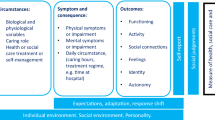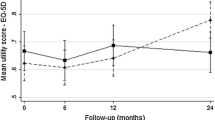Abstract
Background
Within the UK, standard methods of economic evaluation centre on the maximisation of the quality-adjusted life-year (QALY). However, preference-based measures used to estimate QALYs may not be suited to all economic evaluations, as they routinely measure only health outcomes.
Aim
This study used an economic evaluation alongside a clinical trial (EEACT) comparing patients’ preferences for a telephone versus a face-to-face consultation to incorporate process utility into cost-effectiveness analyses.
Methods
An EEACT is described that generates QALYs using Short-form 6-dimension version 1 (SF-6Dv1) responses. These results exclude specific consideration of process utility. A health state valuation study is then reported that bolts a process domain onto the SF-6Dv1 using data obtained from the EEACT. These results therefore include the consideration of process utility. The results of the EEACT with and without process utility are then compared.
Results
This study shows that the QALY, in its current form, does not capture patient benefits associated with the process of receiving healthcare. The EEACT illustrates this, showing a statistically significant difference between control and intervention groups for the patient experience questionnaire communication domain, indicating that patients preferred the intervention. This preference was not identified in the cost-effectiveness outcomes, and the point estimates lie in the north-west quadrant of the cost-effectiveness plane. The preference is captured after adding a communication domain. The point estimate moves to the north-east quadrant, where the intervention is more effective and more costly than the control.
Conclusion
This study indicates that it is possible to capture patients’ preferences for processes associated with care, in a format compatible with the QALY.



Similar content being viewed by others
References
Drummond MF, Sculpher MJ, Torrance GW, O’Brien BJ, Stoddart GL. Methods for the Economic Evaluation of Health Care Programmes. 3rd ed. Oxford Medical Publications; 2015.
Brennan VK. A Study of Process Utility. 2016. http://etheses.whiterose.ac.uk/id/eprint/15202
Mooney G. The benefits of health care. Health Care Anal. 1998;6(2):99–101.
Gerard K, Mooney G. QALY League Tables: handle with care. Health Econ. 1993;2:59–64.
Jones GL, Radley SC, Lumb J, Farkas A. Responsiveness of the electronic Personal Assessment Questionnaire-Pelvic Floor (ePAQ-PF). Int Urogyecol J Pelvic Floor Dysfunct. 2009;20(5):557–64.
Jones G, Brennan V, Jaques R, Wood H, Dixon S, Radley S. Evaluating the impact of a ‘virtual clinic’ on patient experience, personal and provider costs of care in urinary incontinence: a randomised controlled trial. 2018. https://doi.org/10.1371/journal.pone.0189174.
Brazier JE, Roberts J. The estimation of a preference-based measure of health from the SF-12. Med Care. 2004;499:851–9.
Krabbe P, Stouthard M, Essink-Bot M, Bonsel G. The effect of adding a cognitive dimension to the EuroQol Multiattribute Health-Status Classification System. J clin Epidemiol. 1999;52(4):293–301.
Steine S, Finset A, Laerum E. A new, brief questionnaire (PEQ) developed in primary health care for measuring patients’ experience of interaction, emotion and consultation outcome. Fam Pract. 2001;18:410–8.
Torrance GW. Measurement of health state utilities for economic appraisal. J Health Econ. 1986;5:1–30.
Faria R, Gomes M, Epstein D, White IR. A guide to handling missing data in cost-effectiveness analysis conducted within randomised controlled trials. Pharmacoeconomics. 2014;32(12):1157–70.
Gomes M, Grieve R, Nixon R, Ng ES, Carpenter J, Thompson SG. Methods for covariate adjustment in cost-effectiveness analysis that use cluster randomised trials. Health Econ. 2012;21(9):1101–18.
Hoch J, Briggs A, Willan A. Something old, something new, something borrowed, something blue: a framework for the marriage of health econometrics and cost-effectiveness analysis. Health Econ. 2002;11:415–30.
Parkin D, Devlin N. Is there a case for using visual analogue scale valuations in cost-utility analysis. Health Econ. 2006;15:653–64.
Brazier J, Roberts J, Deverill M. The estimation of a preference-based measure of health from the SF-36. J Health Econ. 2002;21920:271–92.
Donaldson C, Shackley P. Does, “process utility” exist? A case study of willingness to pay for laproscopic cholcystectomy. Soc Sci Med. 1997;44:699–707.
Swan J, Sainfort F. Process utility for imaging in cerebrovascular disease. Acad Radiol. 2003;10(3):266–74.
Birch S, Donaldson C. Valuing the benefits and costs of health care programmes: where’s the “extra” in extra-welfarism? Soc Sci Med. 2003;56(5):1121–33.
Brennan VK, Dixon S. Incorporating process utility into quality adjusted life years: a systematic review of empirical studies. Pharmacoeconomics. 2013;31(8):677–91.
Yang Y, Brazier J, Tsuchiya A. The effect of adding a 'sleep' dimension to EQ-5D. Health Economists' Study Group meeting January. 2008.
Brazier J, Rowen D, Tsuchiya A, Yang Y, Young T (2010) What a pain: adding a generic dimension to a condition-specific preference-based measure. HESG Abstract.
Acknowledgements
The authors thank the reviewers for their comments on the draft manuscript.
Author information
Authors and Affiliations
Corresponding author
Ethics declarations
Funding
This work was partially funded by RTI Health Solutions through a supporting PhD fund. Funding for the online survey was obtained from The University of Sheffield, School of Health and Related Research data collection fund.
Conflict of Interest
S Radley is an unsalaried director and shareholder in ePAQ Systems Ltd, a UK national health service (NHS) spin-out technology company, the largest shareholder in which is Sheffield Teaching Hospitals NHS Foundation. VK Brennan, S Dixon, G Jones and S Radley have no conflicts of interest that are directly relevant to the content of this article.
Availability of data and material
Information on the availability of data from the ePAQ EEACT is reported within the relevant publication [6]. For the bolt-on study, ethics approval and patient consent were gained only for results to be shared through publications in academic journals and presented at conferences and can only be published in aggregate form. These data sets are therefore not publicly available. Data enquiries may be directed to the corresponding author.
Ethics approval
The EEACT study protocol was approved by the North Sheffield ethics committee and was registered at www.clinicaltrials.gov (identifier NCT02176330). The process utility valuation study gained ethics approval from The University of Sheffield ethics committee.
Informed consent
Informed consent to participate in the study was obtained from all participants.
Code availability
Coding from the analyses can be obtained from the authors on request. This includes the STATA files for the SUR analyses and production of the cost-effectiveness planes and CEACs, and in SPSS format for the regression analyses run. Coding enquiries may be directed to the corresponding author.
Author contributions
VB was involved in study conception and design, data collection, and analysis and interpretation of results and drafted the manuscript. SD was involved in the study conception and design and advised on the analysis and interpretation of results. GJ and SR led the EEACT. All authors reviewed the results and approved the final version of the manuscript.
Rights and permissions
About this article
Cite this article
Brennan, V.K., Jones, G., Radley, S. et al. Incorporating Process Utility into Cost-Effectiveness Analysis via a Bolt-On Domain to the SF-6D: An Exploratory Study. Appl Health Econ Health Policy 19, 747–756 (2021). https://doi.org/10.1007/s40258-021-00646-4
Accepted:
Published:
Issue Date:
DOI: https://doi.org/10.1007/s40258-021-00646-4




